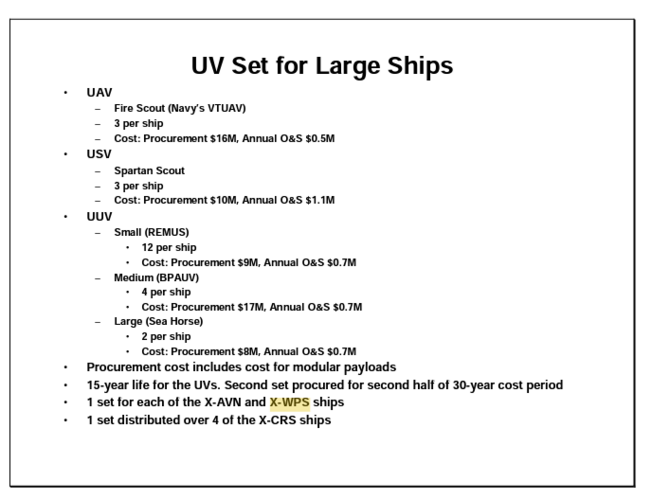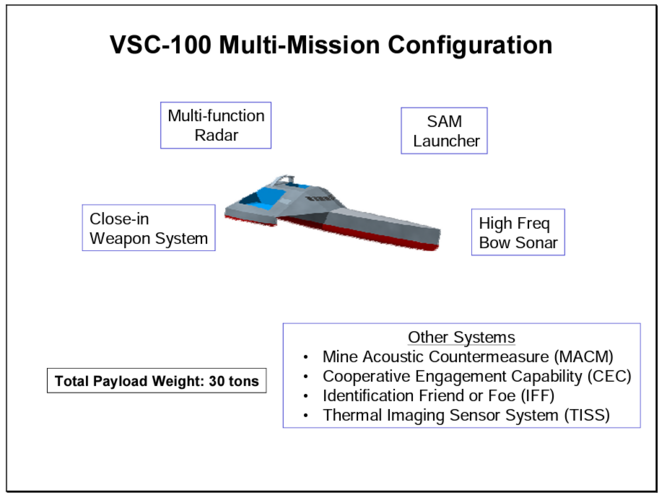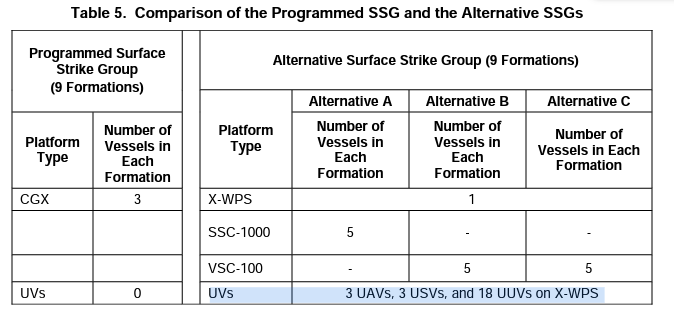that_person
ACCESS: Secret
- Joined
- 25 May 2021
- Messages
- 244
- Reaction score
- 402
Hello all. Today I was doing some research into the AGS's LRLAP shells, trying to confirm a hunch I have that the original unit price was drastically lower than the stated $800,000-$1,000,000. I sort of confirmed that, as well as finding information saying the AGS was supposed to fire other shell types, but that's besides the point. One of the documents I was looking at is some sort of thesis on gun-based NGFS, which quotes the LRLAP having a unit cost of $75,000 in 2007 (about what I expected). That document can be found here:
https://www.defenseindustrydaily.com/files/2007-05_JFSC_Thesis_NFS_and_DDG-1000.pdf
However, there was something else that caught my eye, located on Page 71. It reads as follows:
"The Office of Force Transformation (OFT) called for the construction of a 57,000 ton missile and rocket ship as part of a family of large warships constructed using commercial building practices. This weapons ship concept would have 360 Vertical Launch System (VLS) cells and four trainable rocket launchers. The call for these vessels indicates reputable organizations are aware of the shortfall in NSFS-capable vessels. The OFT weapons ship concept is similar in size to an Iowa class ship as both weigh about 57,000 tons."
That made me do a double-take.
First things first, the "Office of Force Transformation (OFT)" was a short-lived DoD office established by Rumsfeld in October of 2001, with the intention of transforming the military to meet the Bush Admin's vision. For 4 years it was lead by a retired Admiral, until it was passed to someone else in 2005. The OFT was disbanded in October of 2006. Really the only important thing to note here was the OFT was created by Rumsfeld and his goons, and then lead by an Admiral.
The OFT was responsible for a number of... interesting ideas. One such idea was the Alternative Fleet Architecture Design, a study that concluded sometime before August of 2005. I have attached a document below as my source material. The Alternative Fleet Architecture Design examines 3 alternative fleets and their composition, which are mostly comprised of new types of warships.
These new types of ships focus on "Smaller Ships and Improved Payload Fraction" (presumably LCS-type stuff), "Network-Centric Warfare", and "Modularity" (Again, probably referring to LCS-type stuff). It then goes onto describe the benefits of such an approach, specifically how it relates to flexibility and cutting costs. Also note that the document examines 3 potential fleets and their composition. More on that later.
The Alternative Fleet Architecture Design ship concepts can be divided into 2 categories; large and small. The large ships are mostly support vessels and the "Weapon Ship". They share the same 57,000-ton (loaded) hull. There are 3 smaller ships, a corvette, a fast-attack craft, and a 13,500 ton SES Sea Control Ship. We will be discussing the small surface combatants later, so keep them in mind.
The common hull for the larger ships comes directly from the MPF(F) Analysis of Alternatives study. MPF(F) was a early-2000s intended to improve the sealift capacity of the navy. It ultimately resulted in the Maritime Prepositioning Ship Squadrons which are forward deployed with Marine equipment. You can read more about it here:
https://www.globalsecurity.org/military/systems/ship/mpf-f.htm
But now that the background for this project has been established, let's delve back into the root of the question, the "57,000 ton missile and rocket ship". This is the first mention of the ship in the document:

That's really not much to go on. But, googling "X-WPS" gives us another document about the same program. It is attached below.
The new document confirms that the large ships share a common, 57,000-ton hull with one of the MPF(F) ships, which gives them all a top speed of 24 knots (Page 23 in the PDF reader). It also refers to the X-WPS as the "Combat Systems Ship", rather than "Weapons Ship". The second document also gives us more context to help piece together the role of the X-WPS. Remember earlier I said the study was more than just a collection of new ship concepts, it also covers the composition of the fleet (Alternatives A-C) for certain mission groups (Carrier Strike Groups, ESGs, SSGs, and the fleet in total).

Examples of a potential common hull (page 129 on the PDF reader)
According to Table 5 (page 28 on the PDF reader), the SSG makeup table, 3 CG(X)s are equal to 1 X-WPS.

This is restated again,
"A single weapons ship (X-WPS) in all alternatives replaces the three CGX ships in the programmed fleet".
This means that the X-WPS is taking up the air-defense role, rather than just carrying missiles. This is already dubious at best, but this line (page 31 in the PDF reader) doesn't make the situation any better:
"Three CGXs in the programmed fleet are replaced by a single weapons ship (X-WPS) that carries all of the payload of the CGXs but has only one radar (vice three on the CGXs). Thus, the one weapons ship’s sensor coverage will not be as great as that of the three CGXs."
I'm not even sure what to make of that frankly. Although I think the single radar might be bigger than those on the CGXs.
Table 5 also tells us the X-WPS would also act as a mothership for drones, SPECOPS, and the small combatants. This is further elaborated here (page 150 in PDF reader):
"... support for a limited number of aircraft or VTUAVs; accommodations for people; space for UUVs or USVs and modules for the small combatants; integrated landing platform for UV operations; and cranes."
The UAVs and helos would land on an "Integrated Landing Platform", which is apparently a self-deploying floating platform. https://www.globalsecurity.org/military/systems/ship/ilp.htm

X-WPS could also carry mission modules for 2 smaller craft, those are the VSC-100 (100-ton FAC), and the SSC-1000 (1000-ton corvette), both craft are capable of 60 knots. I also believe that the X-WPS may be able to actually carry some VSC-100s, although I can not confirm that.


Now, all the Large Ships share the same civilian hull, which would be passed down from the MPF(F) program. They'd also have 50 civilian crewmembers from the Military Sealift Command, no idea why though. This table is on page 154 of the PDF reader.

Note how the LCS is referred to as "SSC-3000". More on that here:
Moving onto the juicy stuff, the armament. The X-WPS would carry 360 VLS cells, which would be filled with SAMs, BMD missiles, and land-attack missiles. It would also have 4 "Trainable Rocket Launchers", or 4 65 MJ EM guns (I assume these are railguns), for NGFS duties. These seem to be an alternate name for the AGS. The document also talks about using electric propulsion to power lasers further down the road. There's really not much else to talk about here.
Ending this very long post, I just want to touch on a few things. The X-WPS seems to be descended from SC-21 concept 3C3, which hypothesized using a civilian tanker hull as a basis for a warship, claiming the increased volume equated to survivability. But, the 3C3 concept seems to have suffered from not actually having a role, it just... existed. Refining it down to something like the X-WPS makes the concept of using a civilian hull as a basis for a warship somewhat reasonable, but I do think the X-WPS overdoes it, to put it nicely. Trying to replace high-end AAW flagships with a converted merchantmen, which doesn't even have a 360-degree radar arc sounds like a terrible idea.
There are however things that I do like about this study, particularly the LCS tender idea, the extensive use of drones, and the out-of-the-box thinking. But, in my humble opinion, this study was a bit too out-of-the-box, and ultimately shows just how shortsighted the DoD was at the time. Imagine a world where we did go down this route, we would have nothing to confront the rise of the PLAN, and I'm still dubious about "alternate fleet architecture" in general. It certainly poses a very interesting thought experiment, but I think it's best to keep it that way. But overall, I think this is a testament to just how far removed clueless politicians, and even the SecDef, are from the real world. Whenever someone points to the Zumwalt or LCS as an example of bad planning, the Alternative Fleet Architecture Design study is a shining example of just how worse off we could be.
https://www.defenseindustrydaily.com/files/2007-05_JFSC_Thesis_NFS_and_DDG-1000.pdf
However, there was something else that caught my eye, located on Page 71. It reads as follows:
"The Office of Force Transformation (OFT) called for the construction of a 57,000 ton missile and rocket ship as part of a family of large warships constructed using commercial building practices. This weapons ship concept would have 360 Vertical Launch System (VLS) cells and four trainable rocket launchers. The call for these vessels indicates reputable organizations are aware of the shortfall in NSFS-capable vessels. The OFT weapons ship concept is similar in size to an Iowa class ship as both weigh about 57,000 tons."
That made me do a double-take.
First things first, the "Office of Force Transformation (OFT)" was a short-lived DoD office established by Rumsfeld in October of 2001, with the intention of transforming the military to meet the Bush Admin's vision. For 4 years it was lead by a retired Admiral, until it was passed to someone else in 2005. The OFT was disbanded in October of 2006. Really the only important thing to note here was the OFT was created by Rumsfeld and his goons, and then lead by an Admiral.
The OFT was responsible for a number of... interesting ideas. One such idea was the Alternative Fleet Architecture Design, a study that concluded sometime before August of 2005. I have attached a document below as my source material. The Alternative Fleet Architecture Design examines 3 alternative fleets and their composition, which are mostly comprised of new types of warships.
These new types of ships focus on "Smaller Ships and Improved Payload Fraction" (presumably LCS-type stuff), "Network-Centric Warfare", and "Modularity" (Again, probably referring to LCS-type stuff). It then goes onto describe the benefits of such an approach, specifically how it relates to flexibility and cutting costs. Also note that the document examines 3 potential fleets and their composition. More on that later.
The Alternative Fleet Architecture Design ship concepts can be divided into 2 categories; large and small. The large ships are mostly support vessels and the "Weapon Ship". They share the same 57,000-ton (loaded) hull. There are 3 smaller ships, a corvette, a fast-attack craft, and a 13,500 ton SES Sea Control Ship. We will be discussing the small surface combatants later, so keep them in mind.
The common hull for the larger ships comes directly from the MPF(F) Analysis of Alternatives study. MPF(F) was a early-2000s intended to improve the sealift capacity of the navy. It ultimately resulted in the Maritime Prepositioning Ship Squadrons which are forward deployed with Marine equipment. You can read more about it here:
https://www.globalsecurity.org/military/systems/ship/mpf-f.htm
But now that the background for this project has been established, let's delve back into the root of the question, the "57,000 ton missile and rocket ship". This is the first mention of the ship in the document:
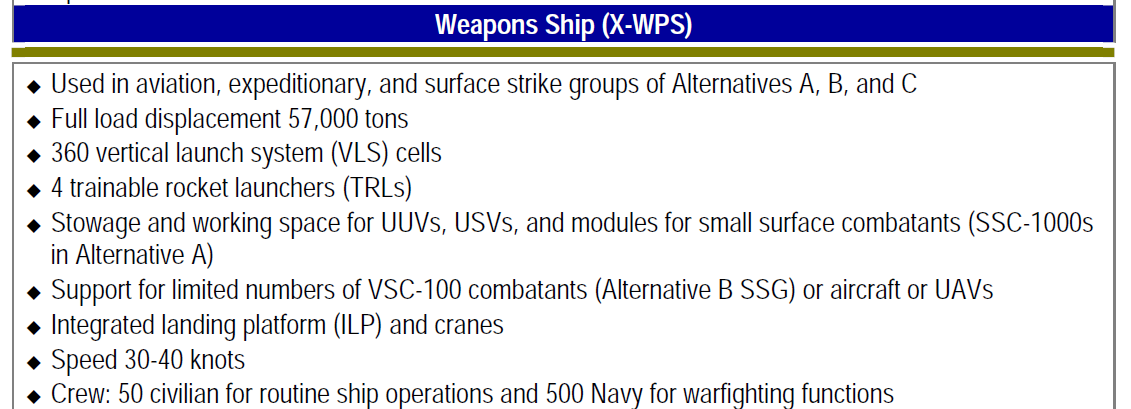
That's really not much to go on. But, googling "X-WPS" gives us another document about the same program. It is attached below.
The new document confirms that the large ships share a common, 57,000-ton hull with one of the MPF(F) ships, which gives them all a top speed of 24 knots (Page 23 in the PDF reader). It also refers to the X-WPS as the "Combat Systems Ship", rather than "Weapons Ship". The second document also gives us more context to help piece together the role of the X-WPS. Remember earlier I said the study was more than just a collection of new ship concepts, it also covers the composition of the fleet (Alternatives A-C) for certain mission groups (Carrier Strike Groups, ESGs, SSGs, and the fleet in total).
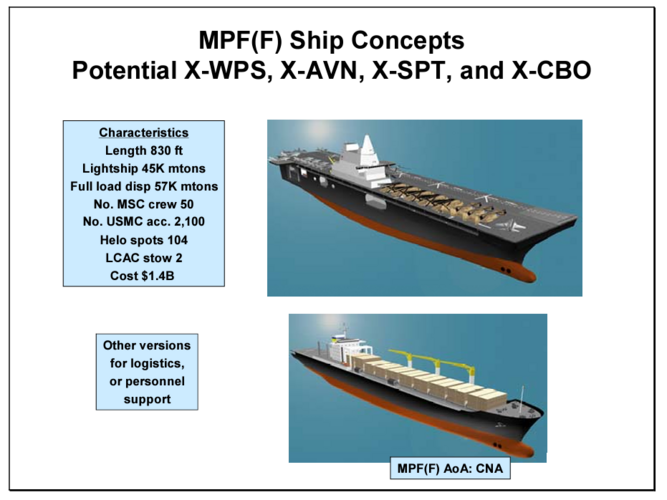
Examples of a potential common hull (page 129 on the PDF reader)
According to Table 5 (page 28 on the PDF reader), the SSG makeup table, 3 CG(X)s are equal to 1 X-WPS.
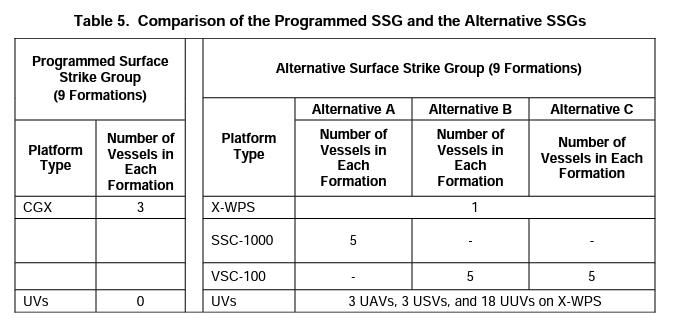
This is restated again,
"A single weapons ship (X-WPS) in all alternatives replaces the three CGX ships in the programmed fleet".
This means that the X-WPS is taking up the air-defense role, rather than just carrying missiles. This is already dubious at best, but this line (page 31 in the PDF reader) doesn't make the situation any better:
"Three CGXs in the programmed fleet are replaced by a single weapons ship (X-WPS) that carries all of the payload of the CGXs but has only one radar (vice three on the CGXs). Thus, the one weapons ship’s sensor coverage will not be as great as that of the three CGXs."
I'm not even sure what to make of that frankly. Although I think the single radar might be bigger than those on the CGXs.
Table 5 also tells us the X-WPS would also act as a mothership for drones, SPECOPS, and the small combatants. This is further elaborated here (page 150 in PDF reader):
"... support for a limited number of aircraft or VTUAVs; accommodations for people; space for UUVs or USVs and modules for the small combatants; integrated landing platform for UV operations; and cranes."
The UAVs and helos would land on an "Integrated Landing Platform", which is apparently a self-deploying floating platform. https://www.globalsecurity.org/military/systems/ship/ilp.htm
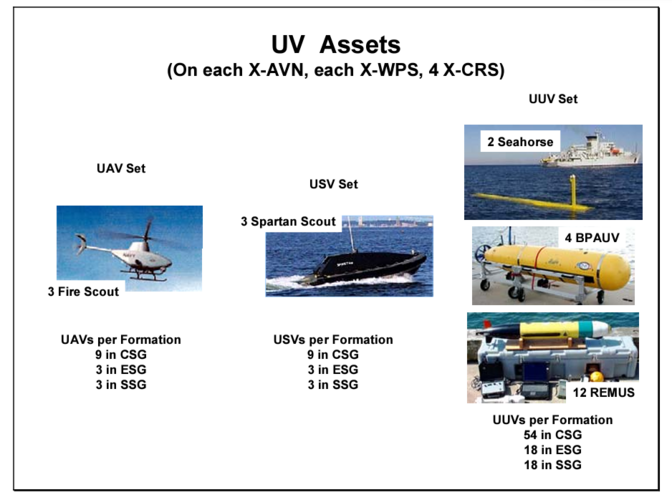
X-WPS could also carry mission modules for 2 smaller craft, those are the VSC-100 (100-ton FAC), and the SSC-1000 (1000-ton corvette), both craft are capable of 60 knots. I also believe that the X-WPS may be able to actually carry some VSC-100s, although I can not confirm that.
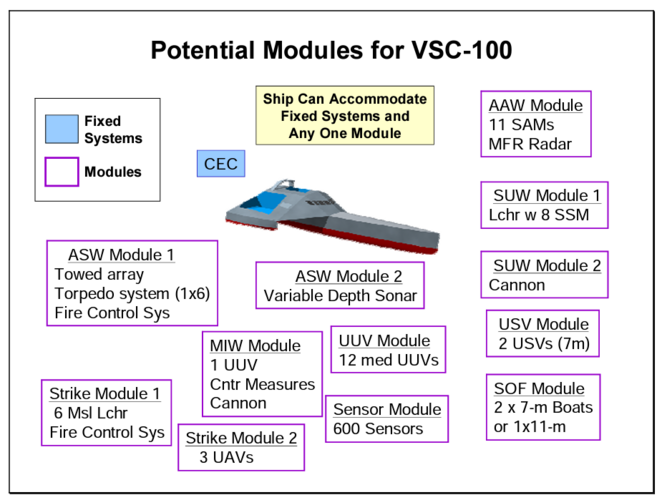
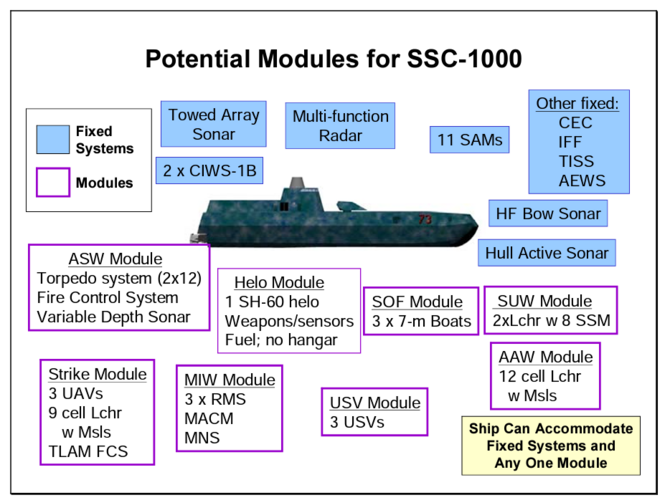
Now, all the Large Ships share the same civilian hull, which would be passed down from the MPF(F) program. They'd also have 50 civilian crewmembers from the Military Sealift Command, no idea why though. This table is on page 154 of the PDF reader.
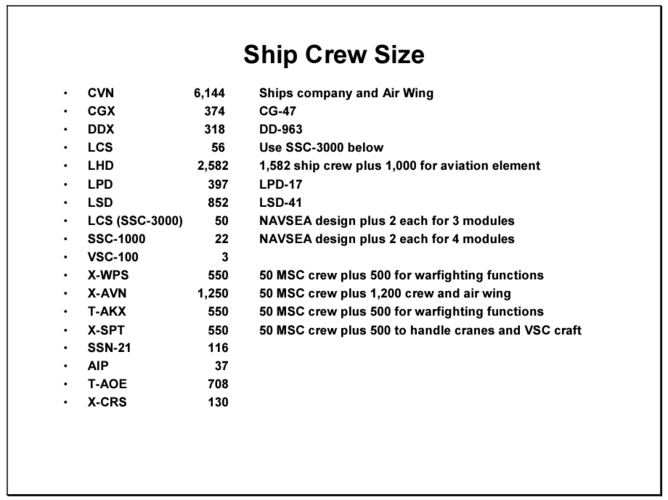
Note how the LCS is referred to as "SSC-3000". More on that here:
Moving onto the juicy stuff, the armament. The X-WPS would carry 360 VLS cells, which would be filled with SAMs, BMD missiles, and land-attack missiles. It would also have 4 "Trainable Rocket Launchers", or 4 65 MJ EM guns (I assume these are railguns), for NGFS duties. These seem to be an alternate name for the AGS. The document also talks about using electric propulsion to power lasers further down the road. There's really not much else to talk about here.
Ending this very long post, I just want to touch on a few things. The X-WPS seems to be descended from SC-21 concept 3C3, which hypothesized using a civilian tanker hull as a basis for a warship, claiming the increased volume equated to survivability. But, the 3C3 concept seems to have suffered from not actually having a role, it just... existed. Refining it down to something like the X-WPS makes the concept of using a civilian hull as a basis for a warship somewhat reasonable, but I do think the X-WPS overdoes it, to put it nicely. Trying to replace high-end AAW flagships with a converted merchantmen, which doesn't even have a 360-degree radar arc sounds like a terrible idea.
There are however things that I do like about this study, particularly the LCS tender idea, the extensive use of drones, and the out-of-the-box thinking. But, in my humble opinion, this study was a bit too out-of-the-box, and ultimately shows just how shortsighted the DoD was at the time. Imagine a world where we did go down this route, we would have nothing to confront the rise of the PLAN, and I'm still dubious about "alternate fleet architecture" in general. It certainly poses a very interesting thought experiment, but I think it's best to keep it that way. But overall, I think this is a testament to just how far removed clueless politicians, and even the SecDef, are from the real world. Whenever someone points to the Zumwalt or LCS as an example of bad planning, the Alternative Fleet Architecture Design study is a shining example of just how worse off we could be.
Attachments
Last edited:

